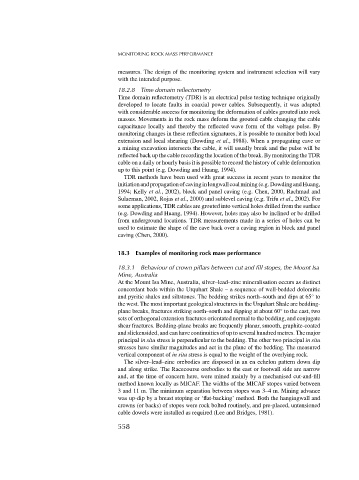Page 576 - Rock Mechanics For Underground Mining
P. 576
MONITORING ROCK MASS PERFORMANCE
measures. The design of the monitoring system and instrument selection will vary
with the intended purpose.
18.2.8 Time domain reflectometry
Time domain reflectometry (TDR) is an electrical pulse testing technique originally
developed to locate faults in coaxial power cables. Subsequently, it was adapted
with considerable success for monitoring the deformation of cables grouted into rock
masses. Movements in the rock mass deform the grouted cable changing the cable
capacitance locally and thereby the reflected wave form of the voltage pulse. By
monitoring changes in these reflection signatures, it is possible to monitor both local
extension and local shearing (Dowding et al., 1988). When a propagating cave or
a mining excavation intersects the cable, it will usually break and the pulse will be
reflected back up the cable recording the location of the break. By monitoring the TDR
cable on a daily or hourly basis it is possible to record the history of cable deformation
up to this point (e.g. Dowding and Huang, 1994).
TDR methods have been used with great success in recent years to monitor the
initiationandpropagationofcavinginlongwallcoalmining(e.g.DowdingandHuang,
1994; Kelly et al., 2002), block and panel caving (e.g. Chen, 2000, Rachmad and
Sulaeman, 2002, Rojas et al., 2000) and sublevel caving (e.g. Trifu et al., 2002). For
some applications, TDR cables are grouted into vertical holes drilled from the surface
(e.g. Dowding and Huang, 1994). However, holes may also be inclined or be drilled
from underground locations. TDR measurements made in a series of holes can be
used to estimate the shape of the cave back over a caving region in block and panel
caving (Chen, 2000).
18.3 Examples of monitoring rock mass performance
18.3.1 Behaviour of crown pillars between cut and fill stopes, the Mount Isa
Mine, Australia
At the Mount Isa Mine, Australia, silver–lead–zinc mineralisation occurs as distinct
concordant beds within the Urquhart Shale – a sequence of well-bedded dolomitic
◦
and pyritic shales and siltstones. The bedding strikes north–south and dips at 65 to
the west. The most important geological structures in the Urquhart Shale are bedding-
◦
plane breaks, fractures striking north–south and dipping at about 60 to the east, two
sets of orthogonal extension fractures orientated normal to the bedding, and conjugate
shear fractures. Bedding-plane breaks are frequently planar, smooth, graphite-coated
and slickensided, and can have continuities of up to several hundred metres. The major
principal in situ stress is perpendicular to the bedding. The other two principal in situ
stresses have similar magnitudes and act in the plane of the bedding. The measured
vertical component of in situ stress is equal to the weight of the overlying rock.
The silver–lead–zinc orebodies are disposed in an en echelon pattern down dip
and along strike. The Racecourse orebodies to the east or footwall side are narrow
and, at the time of concern here, were mined mainly by a mechanised cut-and-fill
method known locally as MICAF. The widths of the MICAF stopes varied between
3 and 11 m. The minimum separation between stopes was 3–4 m. Mining advance
was up-dip by a breast stoping or ‘flat-backing’ method. Both the hangingwall and
crowns (or backs) of stopes were rock bolted routinely, and pre-placed, untensioned
cable dowels were installed as required (Lee and Bridges, 1981).
558

